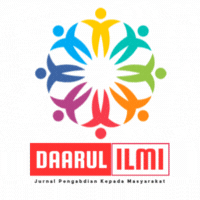Penguatan Peran Serta Organisasi Kemasyarakat dan Mitra Kerja dengan Penyuluhan Mengenai Indikasi dan Kontraindikasi Pemasangan Alat Kontrasepsi
DOI:
https://doi.org/10.52221/daipkm.v1i1.657Keywords:
contraception, contraindications, indicationsAbstract
Introduction: The success of the population and family planning programme is marked by among others a decrease in the population growth rate, a decrease in the fertility rate, an increase in public awareness of the meaning of a small family, an increase in community awareness and participation in managing the family planning programme carried out by the Rural Community Institutions (IMP) cadres. Objective: The purpose of this community service is expected to increase the knowledge IMP cadres with counselling on indications and contraindications for contraceptive insertion so as to increase the success of the family planning programme in the community. Method: The method of implementation is by providing counselling on indications and contraindications for contraceptive insertion. Result: There were 52 IMP cadres who attended counselling on indications and contraindications for contraceptive insertion. The pre-test results before counselling showed that 68% of IMP cadres were able to answer questions correctly. After counselling, posttest results showed that almost all (93%) IMP cadres could answer questions correctly. This proves that the counselling provided can increase the knowledge and understanding of IMP cadres regarding indications and contraindications for contraceptive insertion. Conclusion: The targets were very enthusiastic in participating in this activity. This was evidenced by the number of participants who asked questions when the presentation of the material was finished. The role of IMP cadres is very important in reminding couples of the importance of participating in the family planning programme, and choosing the right contraceptive.
References
Badan Pusat Statistik. (2021). Hasil Sensus Penduduk (SP2020). Retrieved from Bps.Go.Id website: https://www.bps.go.id
Badan Pusat Statistik. (2022). Kabupaten Ciamis Dalam Angka Ciamis Regency in Figures 2022. 1–430. Retrieved from https://ciamiskab.bps.go.id
BKKBN. (2020). Mekanisme Operasional Lini Lapangan Program Bangga Kencana Tahun 2020.
Elysara, N., & Rusnaini, S. (2018). Pelaksanaan Program Keluarga Berencana Alam Meningkatkan Kesejahteraan Keluarga Di Tanah Tumbuh Kabupaten Bungo. Ikra-Ith Humaniora, 2(3), 96–101. Retrieved from https://journals.upi-yai.ac.id/index.php/ikraith-humaniora/article/view/363/244
Hardiningsih, Yuneta, A. E. N., & Yunita dan Fresthy Astrika. (2017). Pengaruh Penyuluhan Terhadap Tingkat Pengetahuan Wanita Usia Subur tentang Alat Kontrasepsi di Wilayah Kerja Puskesmas Sangkrah Kota Surakarta. Jurnal Kesehatan Kusuma Husada, 1(1), 11–15. Retrieved from http://jurnal.ukh.ac.id/index.php/JK/article/view/206
Herowati, D., & Sugiharto, M. (2019). Hubungan Antara Kemampuan Reproduksi, Kepemilikan Anak, Tempat Tinggal, Pendidikan Dan Status Bekerja Pada Wanita Sudah Menikah Dengan Pemakaian Kontrasepsi Hormonal Di Indonesia Tahun 2017. Buletin Penelitian Sistem Kesehatan, 22(2), 91–98. https://doi.org/10.22435/hsr.v22i2.1553
Jurisman, A., Ariadi, A., & Kurniati, R. (2016). Hubungan Karakteristik Ibu dengan Pemilihan Kontrasepsi di Puskesmas Padang Pasir Padang. Jurnal Kesehatan Andalas, 5(1), 191–195. https://doi.org/10.25077/jka.v5i1.467
Kementerian Agama RI. (2017). Al-Qur’an dan Terjemahnya. Bandung: CV Penerbit Jumanatul Ali-Art.
Kementerian Kesehatan RI. (2014). Pedoman Pelayanan Keluarga Berencana. Direktorat Jenderal Bina Kesehatan Ibu Dan Anak, 1(1), 1–80.
Kementerian Kesehatan RI. (2022). Profil Kesehatan Indonesia 2021. In Kementerian Kesehatan Republik Indonesia. Jakarta.
Kementerian Kesehtan RI. (2021). Pedoman Pelayanan Kontrasepsi dan Keluarga Berencana.
Laode Muhamad Sety. (2014). Jenis Pemakaian Kontrasepsi Hormonal dan Gangguan Menstruasi di Wilayah Kerja Puskesmas. Jurnal Kesehatan, 5(1), 60–66.
Notoatmodjo, S. (2014). Promosi Kesehatan dan Ilmu Perilaku. Jakarta: Rineka Cipta.
Prawirohardjo, S. (2017). Ilmu Kandungan. Jakarta: PT. Bina Pustaka Sarwono Prawirohardjo.
Rahmawati, R., & Prianti, A. T. (2022). Penyuluhan Tentang Macam-Macam Alatkontrasepsi di Desa Moncong Loe Kab. Maros. Jurnal Kreativitas Pengabdian Kepada Masyarakat (Pkm), 1(1), 75–80. https://doi.org/10.33024/jkpm.v1i1.5330
Rati Sumanti, Henri Prianto Sinurat, & Ervina Yunita. (2022). Strategi Peningkatan Partisipasi Keluarga Berencana di Kabupaten Kepulauan Mentawai. Jurnal Administrasi Publik, 18(2), 283–300. https://doi.org/10.52316/jap.v18i2.122
Rohmah, H. N. F. (2022). Penyuluhan Pemilihan Alat Kontrasepsi Sesuai Kondisi Kesehatan Akseptor. SELAPARANG: Jurnal Pengabdian Masyarakat Berkemajuan, 6(3), 1375. https://doi.org/10.31764/jpmb.v6i3.10385
Downloads
Published
How to Cite
Issue
Section
License
Copyright (c) 2023 Sri Utami Asmarani, Heni Heryani

This work is licensed under a Creative Commons Attribution 4.0 International License.












